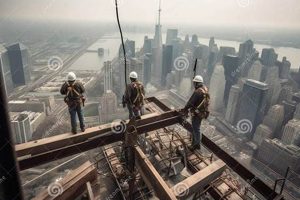Skyscrapers are defined as buildings that rise to a height of at least 150 meters (492 feet) or 50 stories. The term “skyscraper” was first used in the late 19th century to describe the tall buildings that were being constructed in Chicago at the time and has since come to be applied to tall buildings all over the world.
Skyscrapers are important for a number of reasons. They can provide much-needed housing and office space in densely populated areas, and they can also be used to create iconic landmarks that define a city’s skyline. Skyscrapers can also be used to promote sustainability. For example, some skyscrapers are designed to be energy-efficient and to have a reduced environmental impact.
The history of skyscrapers is closely intertwined with the development of new technologies and materials. The first skyscrapers were built using steel frames, which allowed them to be built to greater heights than ever before. In the 20th century, the development of reinforced concrete and glass curtain walls made it possible to build even taller skyscrapers. Today, the tallest skyscrapers in the world are over 800 meters (2,600 feet) tall.
1. Height measurement
Accurately measuring the height of a skyscraper is crucial for various reasons, including structural stability, compliance with building codes, and establishing records. The height measurement of a skyscraper excludes non-permanent fixtures like antennas and decorative spires, providing a standardized reference point for comparison and assessment.
- Structural Considerations
Skyscrapers are designed to withstand immense wind forces and seismic activity. Accurate height measurement is essential for structural engineers to calculate the building’s stability and ensure its safety during extreme events. - Building Codes and Regulations
Building codes often impose height restrictions to ensure public safety and minimize air traffic interference. Accurate height measurement ensures compliance with these regulations, preventing potential hazards and legal issues. - Architectural Design and Aesthetics
Skyscrapers are often designed with distinct architectural features, such as spires and ornamentation. Excluding these non-permanent elements from height measurement allows for a more accurate representation of the building’s core structure and design intent. - Record-keeping and Rankings
Skyscraper height records are closely tracked and celebrated worldwide. Accurate height measurement ensures fair and consistent comparisons, allowing for the recognition of the tallest buildings and the advancement of architectural innovation.
In summary, height measurement plays a critical role in understanding “how tall is a skyscraper.” It provides a standardized reference point for structural assessment, compliance with building codes, architectural design, and the establishment of height records, contributing to the safety, functionality, and iconic status of these towering structures.
2. Height regulations
Height regulations play a crucial role in determining “how tall is a skyscraper” by establishing limits on the vertical development of buildings. These regulations are primarily driven by safety considerations and air traffic concerns, ensuring the well-being of occupants and the safety of aircraft operations.
Safety Considerations
Skyscrapers are subjected to immense wind forces, particularly at higher altitudes. Excessive height can compromise structural stability, increasing the risk of collapse during extreme weather events. Height restrictions help mitigate these risks by limiting the height of buildings to levels that can be safely engineered to withstand anticipated wind loads.
Air Traffic Concerns
Tall buildings can interfere with air traffic, especially near airports. Height regulations help ensure that buildings do not obstruct flight paths or pose hazards to aircraft. By limiting building heights, authorities can maintain safe airspace for takeoffs, landings, and flight operations.
Real-Life Examples
Height regulations vary significantly across cities and countries. For instance, New York City has a height limit of 268 meters (879 feet) to prevent interference with the airspace around LaGuardia Airport. In contrast, Dubai has no city-wide height restrictions, resulting in the construction of supertall skyscrapers like the Burj Khalifa, which stands at 828 meters (2,717 feet).Practical Significance
Understanding height regulations is essential for architects, engineers, and urban planners involved in skyscraper design and construction. By adhering to these regulations, they can ensure the safety and functionality of skyscrapers while respecting airspace requirements. Moreover, height regulations contribute to the overall urban fabric of a city, influencing the skyline and shaping the character of its built environment.
3. Structural engineering
The relationship between structural engineering and the height of a skyscraper is a critical aspect of understanding “how tall is a skyscraper.” As buildings reach greater heights, they face unique structural challenges that require innovative engineering solutions to ensure their stability and safety.
Wind Loads
Skyscrapers are subjected to immense wind forces, which increase with height. These forces can cause swaying and bending, potentially compromising the building’s structural integrity. Engineers employ various techniques to mitigate wind loads, such as utilizing wind-resistant structural systems, incorporating aerodynamic features, and installing tuned mass dampers to reduce vibrations.
Seismic Forces
In earthquake-prone regions, skyscrapers must be designed to withstand seismic forces. Engineers use advanced seismic engineering techniques, such as base isolation systems and energy-dissipating devices, to minimize the impact of earthquakes on the building’s structure. These measures help protect occupants and ensure the building’s stability during seismic events.
Real-Life Examples
The Burj Khalifa, the world’s tallest building, is a testament to the ingenuity of structural engineers. To withstand Dubai’s high wind speeds, the Burj Khalifa employs a buttressed core structural system and a tuned mass damper weighing over 800 tons. These engineering marvels allow the building to sway within safe limits, reducing the risk of damage from wind forces.
Practical Significance
Understanding the role of structural engineering in skyscr
aper design is essential for architects, engineers, and urban planners involved in the construction of tall buildings. By incorporating robust structural systems and advanced engineering techniques, they can create skyscrapers that are not only visually impressive but also safe and resilient in the face of environmental challenges.
Conclusion
The height of a skyscraper is inextricably linked to its structural engineering. As buildings push the boundaries of height, engineers play a crucial role in developing innovative and effective structural solutions to ensure the safety and stability of these architectural marvels.
4. Zoning and density
The relationship between zoning and density, and the height of skyscrapers is a critical aspect of understanding “how tall is a skyscraper.” Zoning regulations play a crucial role in determining the height and density of buildings within a particular area, shaping the overall urban fabric of a city.
Skyscrapers, by their very nature, are designed to maximize vertical space utilization. They allow for higher population density in urban areas, accommodating more people within a smaller footprint. This optimization of land use reduces urban sprawl, preserving valuable green spaces and agricultural areas.
Real-Life Examples
In cities like New York, Tokyo, and Hong Kong, skyscrapers have transformed the urban landscape, creating dense and vibrant neighborhoods. For instance, the Shinjuku Ward in Tokyo is home to a cluster of skyscrapers, including the Tokyo Metropolitan Government Building, resulting in one of the highest population densities in the world.
Practical Significance
Understanding the connection between zoning, density, and skyscraper height is essential for urban planners, architects, and policymakers. By carefully regulating building heights and density, they can promote sustainable urban development, optimize land use, and create livable and efficient cities.
In conclusion, the height of a skyscraper is not solely determined by engineering feats but also by zoning and density regulations. These regulations guide the vertical growth of cities, ensuring optimal land use, reducing urban sprawl, and fostering sustainable urban environments.
5. Sustainability
The relationship between sustainability and the height of skyscrapers is a crucial aspect of understanding “how tall is a skyscraper.” As buildings reach greater heights, they offer unique opportunities to incorporate sustainable design features that promote environmental conservation and reduce ecological impact.
Taller buildings can effectively utilize natural resources like sunlight and rainwater. They can be designed with large windows and skylights to maximize natural lighting, reducing the need for artificial illumination and lowering energy consumption. Additionally, rainwater harvesting systems can collect and store rainwater for non-potable purposes, such as irrigation and toilet flushing, conserving precious water resources.
Real-Life Examples
The Burj Khalifa, the world’s tallest building, is a pioneer in sustainable skyscraper design. It features a double-skin faade that insulates the building, reducing energy consumption for cooling. The building also utilizes a rainwater harvesting system that collects and reuses water for irrigation and other non-potable purposes.
Practical Significance
Understanding the connection between sustainability and skyscraper height is essential for architects, engineers, and urban planners involved in the design and construction of tall buildings. By incorporating sustainable features into skyscrapers, they can contribute to a greener and more sustainable built environment, reducing the ecological footprint of cities and promoting long-term environmental resilience.
Conclusion
The height of a skyscraper not only represents architectural prowess but also provides a platform for sustainable innovation. Taller buildings offer the potential to integrate cutting-edge sustainable design features, setting new standards for environmentally conscious construction and contributing to the creation of sustainable urban environments.
6. Urban planning
The height of a skyscraper is closely tied to urban planning, as it directly influences the building’s role as a landmark and its contribution to the city’s skyline. Skyscrapers, with their towering presence, become iconic symbols that define a city’s identity and character.
- Landmark Status
Skyscrapers, due to their sheer height and architectural prominence, often become landmarks that symbolize a city. They serve as points of reference and orientation, helping people navigate and identify their location within the urban landscape. For example, the Empire State Building in New York City or the Petronas Towers in Kuala Lumpur have become synonymous with their respective cities. - Skyline Definition
The height of a skyscraper significantly impacts its contribution to a city’s skyline. Taller buildings create a more dramatic and recognizable skyline, shaping the overall visual identity of a city. Skylines are often used to represent and identify cities, with iconic skyscrapers serving as distinctive features. For instance, the Burj Khalifa in Dubai has transformed Dubai’s skyline, making it instantly recognizable. - Urban Aesthetics
Skyscrapers, through their height and architectural design, contribute to the overall aesthetic appeal of a city. They can create a sense of grandeur and verticality, adding visual interest and variety to the cityscape. For example, the Shard in London, with its unique pyramidal shape, has become an architectural landmark that enhances the city’s visual appeal. - Economic Development
Skyscrapers, especially those with mixed-use developments, can contribute to a city’s economic development. They can house offices, residential units, retail spaces, and other commercial functions, creating a vibrant hub of activity. For instance, the One World Trade Center in New York City has become a symbol of the city’s resilience and economic revival after the 9/11 attacks.
In conclusion, the height of a skyscraper is not just a measure of its physical presence but also a reflection of its role in urban planning. Skyscrapers, as landmarks, skyline contributors, and aesthetic enhancements, shape the identity and character of cities, while also fostering economic development and creating vibrant urban spaces.
7. Architectural innovation
The relentless pursuit of greater heights in skyscrapers has been a driving force behind architectural innovation. As architects and engineers push the boundaries of vertical construction, they encounter new challenges that demand innovative solutions. These challenges have led to the development of groundbreaki
ng building materials, construction methods, and design concepts that have transformed the way skyscrapers are designed and built.
One of the most significant innovations driven by the pursuit of greater heights is the development of new building materials. Traditional materials like stone and brick have been replaced by lightweight and high-strength materials such as steel, concrete, and glass. These materials allow architects to create taller and more slender structures that can withstand the immense forces of wind and gravity.
In addition to new materials, innovative construction methods have also been developed to meet the challenges of building skyscrapers. These methods include the use of prefabrication, modular construction, and advanced structural systems. Prefabrication involves the construction of building components off-site, which are then assembled on-site. Modular construction involves the use of standardized building modules that can be stacked and combined to create larger structures. Advanced structural systems, such as diagrid structures and outrigger systems, provide additional strength and stability to skyscrapers, enabling them to reach even greater heights.
The pursuit of greater heights has also led to the development of new design concepts that maximize space and natural light while minimizing wind resistance. These concepts include the use of setbacks, curtain walls, and sky gardens. Setbacks are stepped reductions in the width of a building as it rises, which reduces wind resistance and improves structural stability. Curtain walls are non-load-bearing walls made of glass or metal that provide panoramic views and allow natural light to penetrate deep into the building. Sky gardens are open-air spaces incorporated into the design of skyscrapers, providing occupants with access to fresh air and green spaces.
The practical significance of understanding the connection between architectural innovation and the pursuit of greater heights in skyscrapers is immense. It allows architects, engineers, and urban planners to push the boundaries of vertical construction while ensuring the safety and functionality of these iconic structures. By embracing innovation and utilizing new materials, construction methods, and design concepts, we can continue to create taller and more sustainable skyscrapers that contribute to the beauty and functionality of our cities.
8. Economic impact
The height of a skyscraper is closely tied to its economic impact, as taller buildings offer unique opportunities to attract businesses, create jobs, and boost tourism. The sheer scale and grandeur of skyscrapers can make them iconic landmarks that draw attention and investment to a city.
Firstly, skyscrapers can attract businesses by providing prestigious and sought-after office spaces. Many corporations and financial institutions prefer to establish their headquarters in tall buildings, as it conveys a sense of power, success, and global reach. For example, the One World Trade Center in New York City is a prime example of how a skyscraper can become a symbol of economic strength and resilience.
Moreover, skyscrapers create a significant number of jobs during their construction and throughout their lifespan. The design, engineering, and construction of these massive structures require the involvement of architects, engineers, construction workers, and various suppliers. Additionally, once completed, skyscrapers provide ongoing employment opportunities in property management, maintenance, security, and other related services.
Lastly, skyscrapers can boost tourism by becoming iconic landmarks that attract visitors from around the world. Many tall buildings offer observation decks or public spaces that provide breathtaking views of the city and its surroundings. For instance, the Burj Khalifa in Dubai is a major tourist destination, attracting millions of visitors each year who come to witness the world’s tallest building and enjoy the panoramic views from its observation deck.
Understanding the connection between the height of a skyscraper and its economic impact is crucial for urban planners, real estate developers, and policymakers. By recognizing the potential economic benefits of skyscrapers, cities can attract investment, create jobs, and boost their tourism industry. This understanding can guide decision-making processes related to zoning regulations, urban development plans, and the overall economic strategy of a city.
9. Cultural significance
The height of a skyscraper is inextricably linked to its cultural significance. Skyscrapers, with their towering presence and architectural grandeur, have become symbols of ambition, progress, and technological advancement, reflecting the aspirations and achievements of the societies that build them. Understanding this cultural significance is a crucial aspect of comprehending “how tall is a skyscraper.”
Throughout history, skyscrapers have been associated with economic power, innovation, and a drive to reach new heights, both literally and figuratively. The construction of a skyscraper is often seen as a testament to a city’s or nation’s economic prosperity and technological prowess. For example, the Empire State Building in New York City was built during the 1930s, a time of great economic hardship, and became a symbol of hope and resilience during the Great Depression.
Moreover, the ability to build taller and more advanced skyscrapers has been a driving force behind architectural innovation. The quest to construct the world’s tallest building has pushed architects and engineers to develop new structural systems, materials, and construction techniques. This pursuit of verticality has not only led to iconic landmarks but has also advanced the field of architecture and engineering as a whole.
The cultural significance of skyscrapers also lies in their ability to shape the identity of a city or nation. Iconic skyscrapers, such as the Petronas Towers in Kuala Lumpur or the Burj Khalifa in Dubai, have become synonymous with their respective cities and are recognized worldwide as symbols of progress and achievement. These buildings represent the aspirations and ambitions of the people who built them and serve as a source of pride and inspiration.
In conclusion, the height of a skyscraper is not merely a measure of its physical presence but also a reflection of its cultural significance. Skyscrapers embody the hopes, dreams, and technological advancements of societies, serving as landmarks that define skylines and shape the identities of cities and nations. Understanding this cultural significance is essential for appreciating the full meaning and impact of skyscrapers in our world.
Frequently Asked Questions about Skyscraper Heights
This section addresses common questions and misconceptions surrounding the topic of skyscraper heights, providing informative answers based on factual information.
Question 1: How is the height of a skyscraper measured?
Answer: The height of a skyscraper is typically measured from the ground to the top of the architectural structure, excluding antennas, spires, and other non-permanent fixtures. This standardized measurement ensures accurate comparisons and assessment of building heights.
Question 2: What factors influence the height restrictions imposed on skyscrapers?
An
swer: Height restrictions for skyscrapers are primarily driven by safety considerations and air traffic concerns. Building codes regulate building heights to ensure structural stability, minimize wind loads, and prevent interference with aircraft operations.
Question 3: How do structural engineers ensure the stability of tall skyscrapers?
Answer: Structural engineers employ advanced engineering techniques to ensure the stability of tall skyscrapers. These techniques include utilizing wind-resistant structural systems, incorporating aerodynamic features, and installing tuned mass dampers to mitigate wind loads and seismic forces.
Question 4: What are the benefits of building skyscrapers in dense urban areas?
Answer: Skyscrapers offer several benefits in dense urban areas. They optimize land use by allowing for higher population density, reduce urban sprawl, and create opportunities for mixed-use developments, promoting sustainability and economic growth.
Question 5: How do skyscrapers contribute to the cultural significance of a city?
Answer: Skyscrapers often become iconic landmarks that define a city’s skyline and contribute to its identity. They represent a city’s ambition, progress, and technological achievements, becoming symbols of pride and inspiration for its inhabitants.
Question 6: What is the tallest building in the world, and what are its key features?
Answer: The Burj Khalifa in Dubai holds the title of the tallest building globally, standing at an impressive height of 828 meters (2,717 feet). Its key features include a buttressed core structural system, a tuned mass damper, and a double-skin faade that reduces energy consumption.
Summary: Understanding the factors influencing skyscraper heights, the engineering techniques ensuring their stability, and their impact on urban development and cultural significance is crucial for appreciating the architectural marvels that skyscrapers represent.
Transition: These FAQs provide a deeper understanding of the various aspects related to “how tall is a skyscraper,” setting the stage for further exploration of this topic in the following sections.
Tips for Understanding Skyscraper Heights
Understanding the concept of “how tall is a skyscraper” requires careful consideration of various factors and employing effective strategies. Here are some tips to enhance your comprehension:
Tip 1: Grasp the Measurement Standards
Skyscraper heights are measured from the ground to the architectural top, excluding non-permanent structures like antennas. This standardized measurement allows for accurate comparisons and record-keeping.
Tip 2: Explore Height Regulations
Building codes often impose height restrictions for safety and air traffic reasons. Understanding these regulations is crucial for architects, engineers, and urban planners to ensure compliance and maintain structural integrity.
Tip 3: Delve into Structural Engineering
Tall skyscrapers require robust structural systems to withstand wind and seismic forces. Investigate the engineering techniques employed to ensure stability, such as wind-resistant systems and tuned mass dampers.
Tip 4: Examine Urban Planning and Density
Skyscrapers optimize land use by accommodating high population density in urban areas. They help reduce urban sprawl and promote mixed-use developments, contributing to sustainable and vibrant cities.
Tip 5: Consider Sustainable Design Features
Modern skyscrapers integrate sustainability into their design. Explore how they utilize natural lighting, rainwater harvesting, and energy-efficient systems to minimize environmental impact.
Tip 6: Analyze Urban Impact
Skyscrapers serve as landmarks and define city skylines. They contribute to a city’s identity, attract tourism, and stimulate economic growth by creating job opportunities and housing options.
Tip 7: Appreciate Cultural Significance
Skyscrapers embody a city’s ambition and technological prowess. They reflect cultural values and aspirations, becoming symbols of progress and human ingenuity.
Summary: By incorporating these tips, you can develop a comprehensive understanding of the concept “how tall is a skyscraper.” It involves considering measurement standards, regulations, structural engineering, urban planning, sustainability, urban impact, and cultural significance.
Conclusion: Understanding skyscraper heights is not just about numbers; it’s about appreciating the technical, functional, and symbolic aspects that make these architectural marvels significant in shaping our cities and reflecting our aspirations.
Conclusion
Our exploration of “how tall is a skyscraper” has unveiled the intricate interplay between engineering, urban planning, and cultural significance. Skyscrapers, with their towering heights, not only redefine skylines but also reflect the aspirations and achievements of societies.
Understanding skyscraper heights requires considering measurement standards, building regulations, structural innovations, and their impact on urban density and sustainability. These architectural marvels optimize land use, stimulate economic growth, and serve as landmarks that shape a city’s identity. Moreover, skyscrapers embody cultural values, representing ambition, progress, and technological prowess.
As we continue to push the boundaries of vertical construction, it is crucial to embrace sustainable design principles and innovative engineering solutions to create skyscrapers that are not just tall but also environmentally responsible and resilient. The pursuit of greater heights should be guided by a commitment to human well-being and a vision for sustainable urban environments.
By unraveling the complexities of “how tall is a skyscraper,” we gain a deeper appreciation for the engineering ingenuity, urban planning strategies, and cultural significance that converge in these architectural wonders. Skyscrapers stand as testaments to human ambition and serve as reminders of our capacity to build structures that reach for the sky while shaping the cities we live in.







